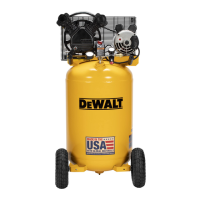
Do you have a question about the DeWalt DXCM301 and is the answer not in the manual?
| Brand | DeWalt |
|---|---|
| Model | DXCM301 |
| Category | Air Compressor |
| Language | English |
Filter for cleaning air entering the pump.
Switch to control the compressor's power state.
Displays the pressure inside the air tank.
Shows the output pressure set by the regulator.
Device used to adjust and control output air pressure.
Connection point for air hoses and tools.
Releases excess pressure to prevent tank rupture.
Valve for draining condensation from the air tank.
Opening for adding oil to the compressor pump.
Plug for draining oil from the compressor pump.
Prevents air from flowing backward into the pump.
Standard connector for attaching air hoses quickly.
Signals an imminent hazardous situation leading to death or serious injury.
Signals a potentially hazardous situation leading to death or serious injury.
Signals a potentially hazardous situation leading to minor injury.
Signals a practice not related to personal injury, may cause property damage.
Precautions for safe tire inflation using the compressor.
Guide to using the AUTO/OFF switch for power control.
Explanation of how the pressure switch operates the motor.
Details the purpose and operation of the safety valve.
Describes how the check valve manages airflow into the tank.
Information on air intake filters and maintaining them.
Description of the air tank drain valve function.
Explains the regulated pressure gauge reading.
Explains the tank pressure gauge reading.
Details the quick connect body and its compatibility.
Instructions for adjusting the air pressure regulator.
Overview of how the air compressor pump works.
Explanation of the motor's overload protection feature.
Steps for unpacking and checking the compressor for damage.
Procedure for safely connecting air hoses to the unit.
Procedure for safely detaching air hoses from the unit.
Instructions for checking the compressor's oil level.
Guidance on the correct type of oil for the compressor.
Ensures compatibility between tools and the compressor.
Guidelines for selecting an optimal operating location.
Advice for operating in high humidity environments.
Safety guidelines for connecting the compressor to electrical power.
Essential steps for properly grounding the electrical system.
Recommendations for using extension cords with the compressor.
Information on electrical circuit requirements and protection.
Steps for safely shutting down the compressor.
Essential checks before operating the compressor.
Required steps for new or repaired compressors.
Detailed steps for the compressor break-in process.
Daily checks to perform before starting the compressor.
Steps for starting the compressor and setting pressure.
Steps for safely shutting down and storing the compressor.
Procedure to verify the safety valve is functioning correctly.
Inspecting and maintaining the air filter for optimal performance.
Steps for draining condensation from the air tank.
Procedures for checking and changing the compressor oil.
Detailed instructions for replacing the compressor drive belt.
Procedure for setting the correct tension on the drive belt.
Steps to align the motor pulley and flywheel correctly.
Procedure for a technician to inspect pump valves.
Method to check air lines and fittings for any leaks.
How to check and tighten compressor head bolts.
Steps for replacing or cleaning the check valve.
Information on optional accessories available for the compressor.
Data needed when contacting for service.
Guidance on obtaining professional maintenance and repairs.
Specifics on warranty periods for compressor parts.
Lists items and conditions not covered by the warranty.
Components considered normal wear and not covered after the initial period.
Further exclusions including labor, travel, and specific damages.
Warranty terms for parts bought individually.
Instructions for requesting warranty service.
